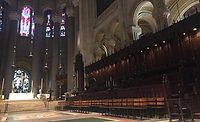Canterbury Cathedral upgrades video surveillance for a new generation of visitors

St. Augustine, the first Archbishop of Canterbury, arrived on the coast of Kent in the United Kingdom as a missionary to England in 597 AD. According to the Canterbury Cathedral's historians, It is said that Gregory had been struck by the beauty of Angle slaves he saw for sale in the city market and dispatched Augustine and some monks to convert them to Christianity. Augustine was given a church at Canterbury (St. Martin’s, after St. Martin of Tours, still standing today) by the local King. This building had been a place of worship during the Roman occupation of Britain and is the oldest church in England still in use.
Augustine had been consecrated a bishop in France and was later made an archbishop by the Pope. He established his seat within the Roman city walls (the word cathedral is derived from the the Latin word for a chair ‘cathedra’, which is itself taken from the Greek ‘kathedra’ meaning seat.) and built the first cathedral there, becoming the first Archbishop of Canterbury. Since that time, there has been a community around the Canterbury Cathedral, arguably one of the oldest organizations in the English speaking world.
Augustine’s original building lies beneath the floor of the Nave – it was extensively rebuilt and enlarged by the Saxons, and the Cathedral was rebuilt completely by the Normans in 1070 following a major fire. There have been many additions to the Canterbury Cathedral over the last nine hundred years, but parts of the Quire and some of the windows and their stained glass date from the 12th century. By 1077, Archbishop Lanfranc had rebuilt it as a Norman church, described as “nearly perfect”. A staircase and parts of the North Wall – in the area of the North West transept also called the Martyrdom – remain from that building.
There's a long, rich history at this site, one of the oldest and most famous Christian structures in England and a UNESCO World Heritage Site. To bring the Canterbury Cathedral to a new generation of visitors and protect the site's history and assets, the leadership embarked on a seven-year, $34 million renovation and upgrade project that included a new visitor center and a robust video surveillance system that would combine discrete video monitoring with high-performance image capture and quality.
The new visitor center, housing retail facilities, a viewing gallery, and community studio exhibition space, are now protected with a video solution from IDIS.
Specialist systems integrator Hall & Kay Security Engineering was tasked with delivering a solution that would be affordable, easy-to-use, and allow for comprehensive real-time monitoring, while ensuring reliable recording without data loss. And because this was part of a much wider project, the video technology needed to be fast and easy to install – essential for avoiding project overruns in this complex, multidisciplinary construction environment, and preventing any delays to the new Welcome Center’s opening.
The IDIS end-to-end technology solution incorporates cameras, recorders, VMS, and essential peripherals. Also of interest to Canterbury leadership was the system's cybersecurity protection, which has multi-layered encryptions and proprietary protocols to safeguard sensitive video data.
To give high-definition video coverage of the Welcome Center’s entrances, retail area and exhibition spaces, Hall & Kay installed IDIS Full HD DC-4223WRX IR dome cameras. These vandal-resistant models are equipped with varifocal lenses, true WDR and IR LED to deliver images in challenging and variable lighting conditions. They connect to three 16-channel DD-1216 NVRs to handle recording and deliver 480ips live view with no visible latency.
The plug-and-play system allowed for connectivity and mutual two-factor authentication of devices streamlined cybersecurity measures.
In addition, a license-free video management system gives the Cathedral Constable and security team the ability to configure specific user permissions to give senior staff and system administrators access to video footage.
Looking for a reprint of this article?
From high-res PDFs to custom plaques, order your copy today!





